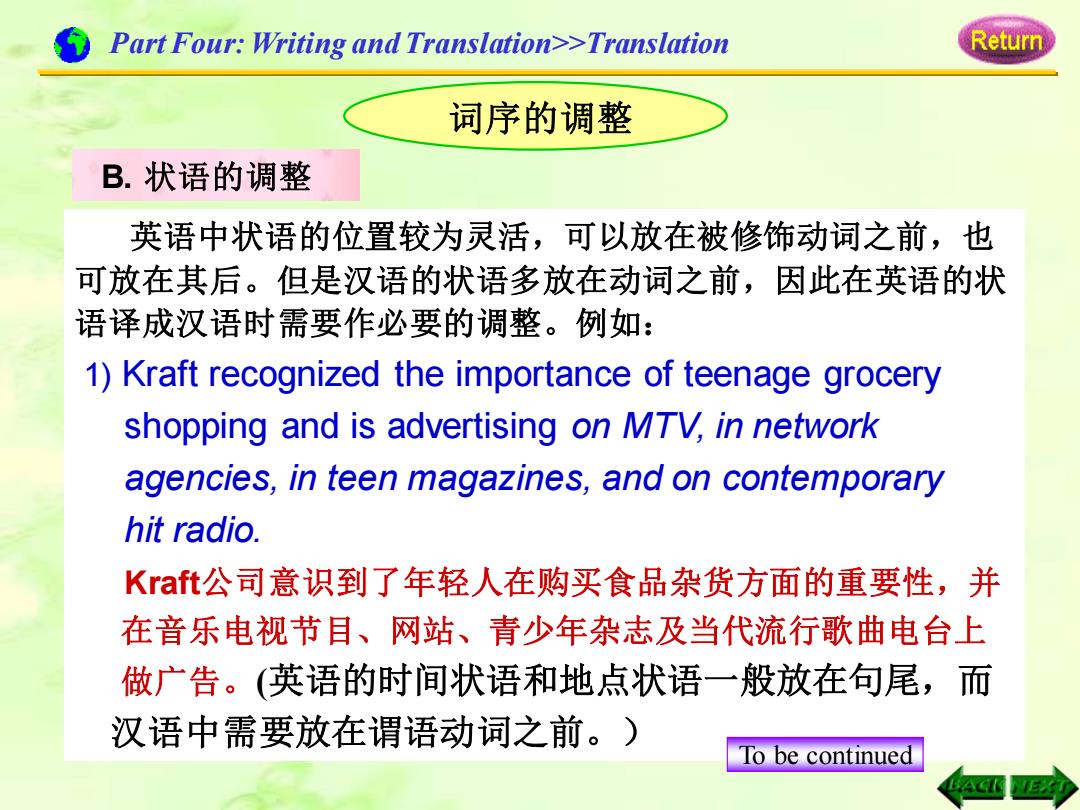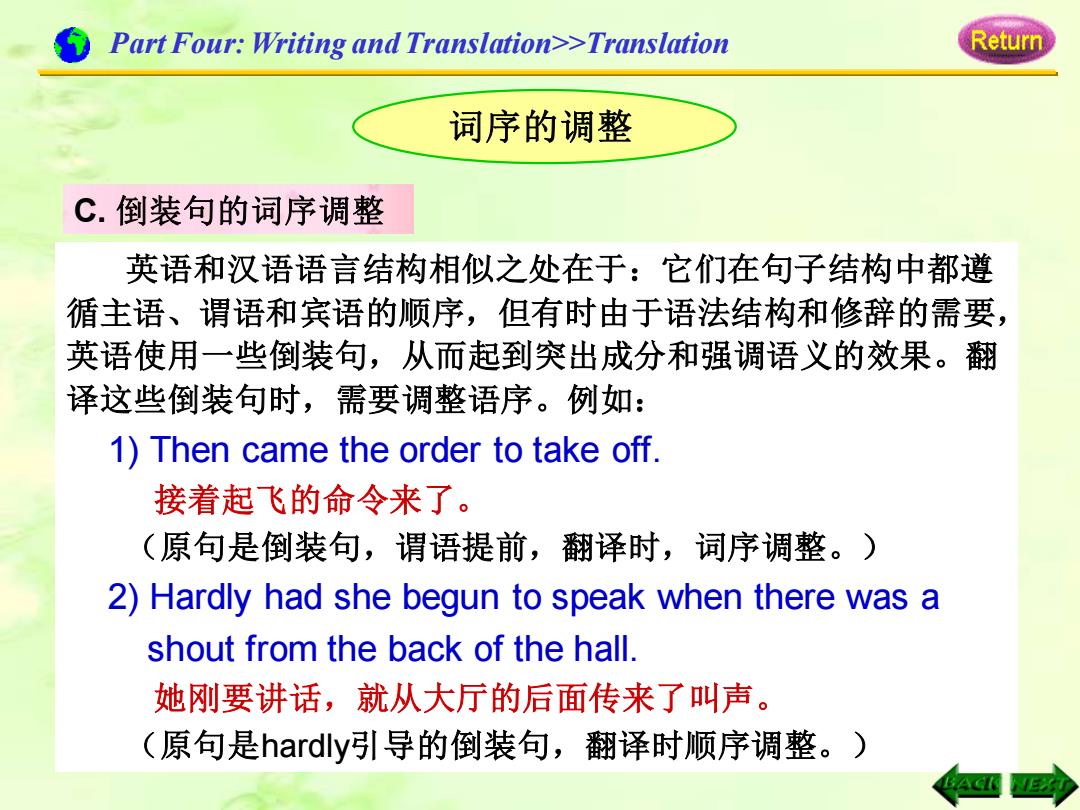
Part Four:Writing and Translation>>Translation Return ☆汉译英中定语翻译要点 2)它是唯一健在的能做到这点的人。 He's the only man alive who could do it. ● 某些以-ible或-able结尾的形容词用作定语,在与 every、the only或形容词最高级连用来修饰一个名词 时,也常放在所修饰名词之后。例如: )他遭受了能想得出的最可怕的虐待。 He had been subjected to the most terrible abuse imaginable. 2)目前他是唯一可以搞培训的医生。 At present he is the only doctor available for the training program
2) 它是唯一健在的能做到这点的人。 He’s the only man alive who could do it. ● 某些以-ible或-able结尾的形容词用作定语,在与 every、the only 或形容词最高级连用来修饰一个名词 时,也常放在所修饰名词之后。例如: 1) 他遭受了能想得出的最可怕的虐待。 He had been subjected to the most terrible abuse imaginable. 2) 目前他是唯一可以搞培训的医生。 At present he is the only doctor available for the training program. ☆ 汉译英中定语翻译要点 Part Four: Writing and Translation>>Translation

Part Four:Writing and Translation>>Translation Return 词序的调整 B.状语的调整 英语中状语的位置较为灵活,可以放在被修饰动词之前,也 可放在其后。但是汉语的状语多放在动词之前,因此在英语的状 语译成汉语时需要作必要的调整。例如: 1)Kraft recognized the importance of teenage grocery shopping and is advertising on MTV,in network agencies,in teen magazines,and on contemporary hit radio. Kraft公司意识到了年轻人在购买食品杂货方面的重要性,并 在音乐电视节目、网站、青少年杂志及当代流行歌曲电台上 做广告。(英语的时间状语和地点状语一般放在句尾,而 汉语中需要放在谓语动词之前。) To be continued
词序的调整 B. 状语的调整 英语中状语的位置较为灵活,可以放在被修饰动词之前,也 可放在其后。但是汉语的状语多放在动词之前,因此在英语的状 语译成汉语时需要作必要的调整。例如: 1) Kraft recognized the importance of teenage grocery shopping and is advertising on MTV, in network agencies, in teen magazines, and on contemporary hit radio. Kraft公司意识到了年轻人在购买食品杂货方面的重要性,并 在音乐电视节目、网站、青少年杂志及当代流行歌曲电台上 做广告。(英语的时间状语和地点状语一般放在句尾,而 汉语中需要放在谓语动词之前。) To be continued Part Four: Writing and Translation>>Translation

Part Four:Writing and Translation>>Translation Return 词序的调整 B.状语的调整 2) Students went out of the classroom,laughing and talking. 学生们说说笑笑地从教室里出来。 (英语中表示伴随情况的状语在译成汉语时放在谓语 动词之前。) 但也有例外: They,unexpectedly,did not come to the class. 他们没有来上课,这完全是意料之外的事
词序的调整 B. 状语的调整 2) Students went out of the classroom, laughing and talking. 学生们说说笑笑地从教室里出来。 (英语中表示伴随情况的状语在译成汉语时放在谓语 动词之前。) 但也有例外: They, unexpectedly, did not come to the class. 他们没有来上课,这完全是意料之外的事。 Part Four: Writing and Translation>>Translation

Part Four:Writing and Translation>>Translation Return 词序的调整 C.倒装句的词序调整 英语和汉语语言结构相似之处在于:它们在句子结构中都遵 循主语、谓语和宾语的顺序,但有时由于语法结构和修辞的需要, 英语使用一些倒装句,从而起到突出成分和强调语义的效果。翻 译这些倒装句时,需要调整语序。例如: 1)Then came the order to take off. 接着起飞的命令来了。 (原句是倒装句,谓语提前,翻译时,词序调整。) 2)Hardly had she begun to speak when there was a shout from the back of the hall. 她刚要讲话,就从大厅的后面传来了叫声。 (原句是hardly引导的倒装句,翻译时顺序调整。)
英语和汉语语言结构相似之处在于:它们在句子结构中都遵 循主语、谓语和宾语的顺序,但有时由于语法结构和修辞的需要, 英语使用一些倒装句,从而起到突出成分和强调语义的效果。翻 译这些倒装句时,需要调整语序。例如: 1) Then came the order to take off. 接着起飞的命令来了。 (原句是倒装句,谓语提前,翻译时,词序调整。) 2) Hardly had she begun to speak when there was a shout from the back of the hall. 她刚要讲话,就从大厅的后面传来了叫声。 (原句是hardly引导的倒装句,翻译时顺序调整。) 词序的调整 C. 倒装句的词序调整 Part Four: Writing and Translation>>Translation